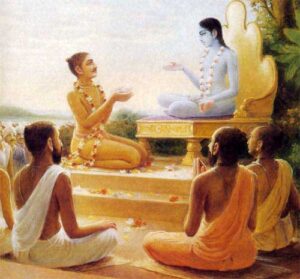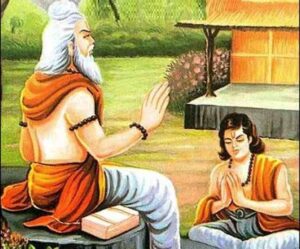“The mediocre teacher tells. The good teacher explains. The superior teacher demonstrates. The great teacher inspires.”
– William Arthur Ward
Guru Purnima, also spelt as Guru Poornima, is an auspicious and significant Hindu festival celebrated in India and other countries with a Hindu population. It falls on the full moon day (Purnima) in the Hindu month of Ashadha, which typically corresponds to June or July in the Gregorian calendar.
The festival is dedicated to expressing gratitude and reverence towards spiritual teachers or gurus. The word “Guru” in Sanskrit means “dispeller of darkness,” and it refers to someone who guides their disciples or followers on the path of knowledge, wisdom, and spiritual enlightenment.
 On Guru Purnima, devotees pay tribute to their teachers, gurus, mentors, or anyone who has played a vital role in their personal or spiritual growth. They express their gratitude and seek blessings from their gurus. The day is also an opportunity for self-reflection and learning, with devotees resolving to deepen their knowledge and practice of their chosen spiritual path.
On Guru Purnima, devotees pay tribute to their teachers, gurus, mentors, or anyone who has played a vital role in their personal or spiritual growth. They express their gratitude and seek blessings from their gurus. The day is also an opportunity for self-reflection and learning, with devotees resolving to deepen their knowledge and practice of their chosen spiritual path.
In India, celebrations often involve visiting temples, performing special prayers, singing devotional songs, and participating in spiritual discourses or lectures. Many people offer gifts, flowers, or fruits to their gurus as a symbol of respect and appreciation.
The festival is not limited to any specific religion and is also observed by Buddhists and Jains who honour their teachers and spiritual guides on this day. Guru Purnima is a time to recognize the importance of knowledge and the role of teachers in shaping individuals and society.
The First Story of Guru Purnima:
Once upon a time, four elderly men embarked on a quest for answers to their individual dilemmas. The first man, burdened by misery, sought a way out of his sorrow. The second yearned for progress and success, eager to learn the path to achieve it. The third contemplated the profound meaning of life, longing for understanding. Meanwhile, the fourth man, already knowledgeable, grappled with an inexplicable void in his life.
Their journeys led them to a serene spot adorned by a majestic Banyan tree, where a young man sat with a beaming smile. Intrigued, they all believed he held the key to their questions. Without uttering a single word, the young man beneath the Banyan tree provided each of them with the answers they sought, leaving them satisfied.
This account narrates the inaugural tale of Guru Purnima, which occurred on a night illuminated by the full moon. It marks the inception of the Guru Parampara, the lineage of the Guru tradition. Notably, all four elderly individuals in this story evolved into Gurus themselves.
 Their aspirations were fulfilled in the following ways:
Their aspirations were fulfilled in the following ways:
The first person’s misery dissipated, departing from their existence.
The second individual experienced an influx of abundance and joy.
The third seeker’s quest ceased as they attained the knowledge of life’s meaning.
As for the knowledgeable fourth person, who possessed vast wisdom, they yearned for a Guru to establish a deeper connection. Eventually, their inner link with a Guru was established.
These profound occurrences reflect the words of Adi Shankaracharya, who revered Dakshinamurthy, the first Guru. Adi Shankaracharya extolled Dakshinamurthy’s ability to elucidate the true essence of the supreme Brahman through his profound silence.
The Symbolism of the Story:
In the story, the teacher appears youthful because the spirit remains perpetually young, while the students are depicted as old. Several similes support this notion, emphasizing that the pursuit of desires or liberation can age an individual. Consequently, the disciples were portrayed as old, while the Master remained youthful.
Regarding the symbolism of the Banyan tree, it stands as a representation of self-sufficiency and resilience. The Banyan tree thrives independently, requiring no external care or protection. Even in challenging conditions, such as growing in the crevice of a stone with minimal water, it can flourish with just a little mud or sometimes even none. Furthermore, the Banyan tree continuously releases oxygen, making it a unique tree that provides oxygen around the clock. This characteristic mirrors the Guru Principle, signifying an all-giving nature akin to that of a true spiritual teacher or guru.
Guru means the one who removes darkness, misery, loneliness, and lack and brings abundance because lack is only in the mind. So the Guru removes the lack and brings freedom.
The History of Guru Purnima:
The history of Guru Purnima is deeply rooted in ancient Indian traditions and has a long and significant history. The festival has evolved over time and has been celebrated in different ways across various spiritual traditions. Here’s a brief overview of the historical significance of Guru Purnima:
Ancient Vedic Roots: The concept of a guru, a revered spiritual teacher, can be traced back to ancient Vedic scriptures. In the Vedic period, students would gather to receive knowledge from their gurus during the four-month-long monsoon season, known as “Chaturmas.” The period concluded with Guru Purnima, which was the day when the students expressed their gratitude and reverence to their teachers.
 Vyasa Puja: One of the most influential historical figures associated with Guru Purnima is Ved Vyasa, the legendary sage and compiler of the Vedas, the ancient sacred texts of Hinduism. Guru Purnima is believed to be the birth anniversary of Ved Vyasa. He is revered as one of the greatest gurus and scholars in Hindu tradition. On this day, disciples pay homage to Vyasa and all spiritual teachers who carry forward his legacy of imparting knowledge and wisdom.
Vyasa Puja: One of the most influential historical figures associated with Guru Purnima is Ved Vyasa, the legendary sage and compiler of the Vedas, the ancient sacred texts of Hinduism. Guru Purnima is believed to be the birth anniversary of Ved Vyasa. He is revered as one of the greatest gurus and scholars in Hindu tradition. On this day, disciples pay homage to Vyasa and all spiritual teachers who carry forward his legacy of imparting knowledge and wisdom.
Mahabharata Connection: According to the Hindu epic Mahabharata, it was on the day of Guru Purnima that Lord Krishna, considered a divine guru by many, imparted the teachings of the Bhagavad Gita to his disciple Arjuna on the battlefield of Kurukshetra. This association further emphasizes the importance of spiritual guidance and the significance of this day.
Buddhist Tradition: Guru Purnima is also significant in Buddhism as it is believed to be the day when Gautama Buddha, the founder of Buddhism, gave his first sermon after attaining enlightenment. This event, known as Dhammacakkappavattana Sutta, marked the beginning of his teaching journey, and therefore, Guru Purnima is an important day for Buddhists to remember their spiritual teachers.
 Jain Tradition: In Jainism, Guru Purnima holds importance as it is believed to be the day when Lord Mahavira, the 24th Tirthankara, made his first disciple. Tirthankaras are spiritual teachers who attain enlightenment and guide others on the path of liberation.
Jain Tradition: In Jainism, Guru Purnima holds importance as it is believed to be the day when Lord Mahavira, the 24th Tirthankara, made his first disciple. Tirthankaras are spiritual teachers who attain enlightenment and guide others on the path of liberation.
Over time, the celebration of Guru Purnima has expanded beyond specific religious boundaries. People from different spiritual backgrounds use this occasion to honour and express gratitude to their teachers, mentors, and guides who have played a significant role in their personal and spiritual growth. The festival continues to be an essential part of the Indian cultural and spiritual landscape, fostering a deep sense of respect for knowledge, wisdom, and guidance provided by spiritual teachers.
Significance of Guru Purnima:
Guru Purnima holds immense significance in various spiritual and cultural aspects. Here are some of the key significances of this auspicious festival:
Reverence to Gurus: Guru Purnima is primarily dedicated to showing gratitude and respect to spiritual teachers, mentors, and guides who have imparted knowledge and wisdom to their disciples. It is an opportunity for disciples to express their reverence and appreciation for the valuable guidance provided by their gurus.
 Spiritual Growth: The festival emphasizes the importance of the guru-disciple relationship in spiritual growth and self-realization. Gurus play a vital role in guiding their disciples on the path of righteousness, self-awareness, and enlightenment.
Spiritual Growth: The festival emphasizes the importance of the guru-disciple relationship in spiritual growth and self-realization. Gurus play a vital role in guiding their disciples on the path of righteousness, self-awareness, and enlightenment.
Acknowledgement of Knowledge: Guru Purnima is a reminder of the importance of knowledge and its role in shaping individuals and society. The festival encourages seekers to pursue knowledge and wisdom to lead a purposeful and meaningful life.
Tradition and Heritage: Guru Purnima is deeply rooted in ancient Indian traditions and reflects the country’s rich cultural heritage. It serves as a link to the past and helps preserve the age-old practice of respecting and honouring gurus.
Guru as a Role Model: Gurus are not only sources of knowledge but also exemplars of virtuous living. Guru Purnima encourages followers to emulate their gurus’ positive qualities and incorporate their teachings into their daily lives.
Disciple’s Responsibility: The festival highlights the responsibility of disciples to uphold the teachings of their gurus and carry forward their legacy. It inspires followers to become responsible torchbearers of the knowledge they receive.
 Transcending Boundaries: Guru Purnima transcends religious and cultural boundaries. While it is prominent in Hinduism, it is also celebrated in Buddhism, Jainism, and other spiritual traditions. The universality of the festival underscores the importance of spiritual guidance and knowledge across different belief systems.
Transcending Boundaries: Guru Purnima transcends religious and cultural boundaries. While it is prominent in Hinduism, it is also celebrated in Buddhism, Jainism, and other spiritual traditions. The universality of the festival underscores the importance of spiritual guidance and knowledge across different belief systems.
Personal Transformation: On Guru Purnima, individuals engage in introspection and self-improvement. They resolve to overcome their shortcomings, develop inner qualities, and progress on their spiritual journey.
Beginning of Spiritual Practice: For some individuals, Guru Purnima marks the initiation into spiritual practices and the formal acceptance of a guru as their spiritual guide. It symbolizes the commencement of a new phase in their life dedicated to self-discovery and spiritual exploration.
Community Bonding: The festival fosters a sense of community and camaraderie among disciples and devotees who gather to celebrate and pay homage to their gurus. It strengthens the spiritual bond between like-minded individuals who share a common path.
In essence, Guru Purnima is a day of remembrance, reflection, and celebration of the timeless guru-disciple relationship, promoting the pursuit of knowledge and spiritual evolution. It is a day to honour the guiding light that helps seekers navigate the complexities of life and find a higher purpose and meaning.


